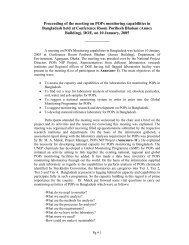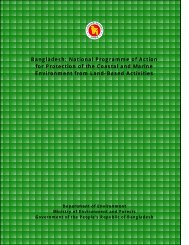Draft CMP HH - the Department of Environment
Draft CMP HH - the Department of Environment
Draft CMP HH - the Department of Environment
You also want an ePaper? Increase the reach of your titles
YUMPU automatically turns print PDFs into web optimized ePapers that Google loves.
Coastal and Wetland Biodiversity Management Project BGD/99/G31<br />
Hakaluki Haor <strong>Draft</strong> Conservation Management Plan<br />
� Current varieties <strong>of</strong> rice being cultivated including both HYV and indigenous varieties<br />
� Preferred soil types <strong>of</strong> each rice variety<br />
� Cropping intensity and rotation (how many crops/ unit area/ year)<br />
� Yield <strong>of</strong> each rice variety<br />
� Land preparation requirements (animal driven plough, ladder, tractor)<br />
� Type <strong>of</strong> planting material (seed, seedling, wilding)<br />
� Sources <strong>of</strong> planting materials (self, private entrepreneur, NGO, GO)<br />
� Pest and diseases associated with each agricultural crop (animal, insect, fungus)<br />
� Pest and disease control (scarecrow, chemicals, biological control, o<strong>the</strong>r indigenous<br />
methods)<br />
� Major irrigation methods (natural source, shallow tube well, deep tube well)<br />
� Weeds and weeding including identification <strong>of</strong> <strong>the</strong> major weeds and approaches for control<br />
(manual, chemical etc.)<br />
� Use <strong>of</strong> fertilisers and manure (manure: cow dung, compost, left over stumps, fertilisers: N,<br />
P, K and o<strong>the</strong>r micronutrients, amount used per unit area, fertiliser application method, time<br />
<strong>of</strong> year fertilisers are applied<br />
� Problems associated with existing cropping patterns<br />
� Agricultural impacts on <strong>the</strong> surrounding ecosystem<br />
� Economic viability <strong>of</strong> each different agricultural crop<br />
� Rate <strong>of</strong> agricultural encroachment within <strong>the</strong> ECA<br />
� Different groups involved in farming including and <strong>the</strong> role <strong>the</strong>y each plays in agricultural<br />
production<br />
• Prepare a separate report documenting all <strong>the</strong> indigenous rice varieties found in <strong>the</strong> Hakaluki<br />
Haor ECA<br />
• Undertake an cost-benefit analysis comparing HYV and indigenous rice varieties taking into<br />
consideration <strong>the</strong> long-term impacts on <strong>the</strong> environment<br />
• Investigate <strong>the</strong> possibility <strong>of</strong> re-introducing economically viable indigenous rice varieties<br />
• Provide technical, and where feasible financial, support to local farmers attempting to reintroduce<br />
indigenous rice varieties<br />
• Help farmers identify markets for indigenous rice varieties<br />
• Provide technical support to farmers cultivating HYV rice aimed at reducing soil degradation<br />
and <strong>the</strong> ecological impacts <strong>of</strong> agro-chemical use<br />
• Provide technical support to local farmers to identify natural and less harmful alternatives to<br />
herbicides, pesticides, fungicides, and fertilisers<br />
Primary Outcome/ Output<br />
• Agricultural is managed sustainably with increasing trends towards organic production<br />
• Indigenous rice varieties are re-introduced<br />
Constraints<br />
• Local farmers may resist becoming involving in <strong>the</strong> re-introduction <strong>of</strong> indigenous rice varieties<br />
as short-term rewards may not be incentive enough<br />
Prepared by UNOPS Consultant Mr. Sulma Warne August/ September 2005 for Project BGD/99/G31 29





